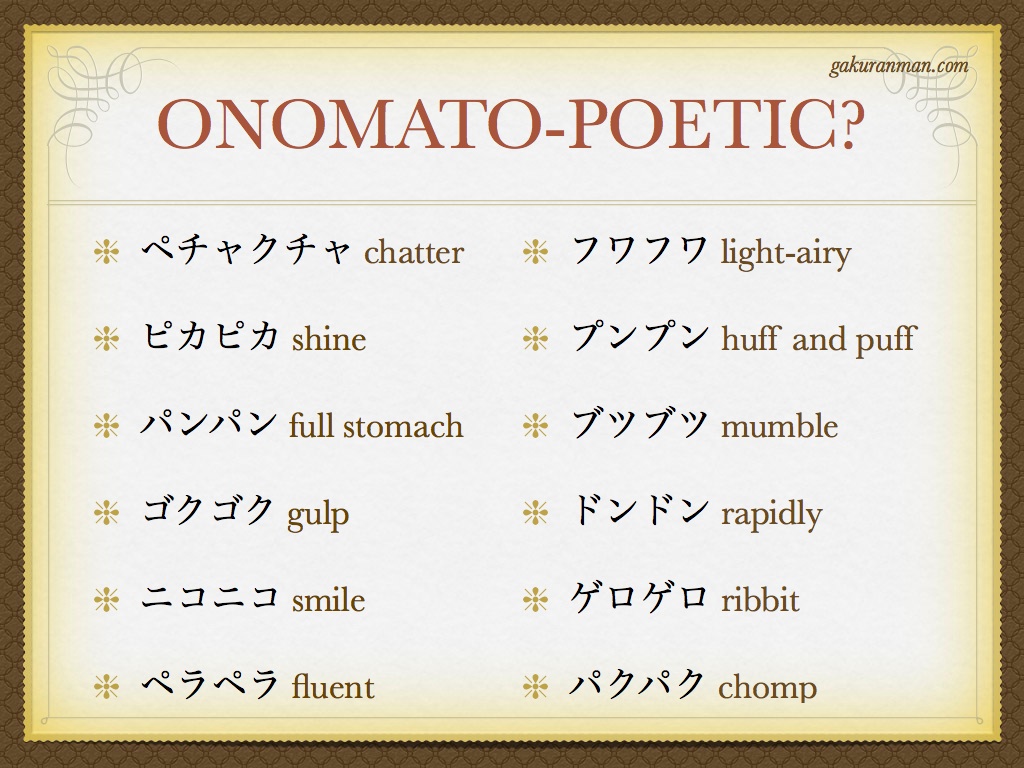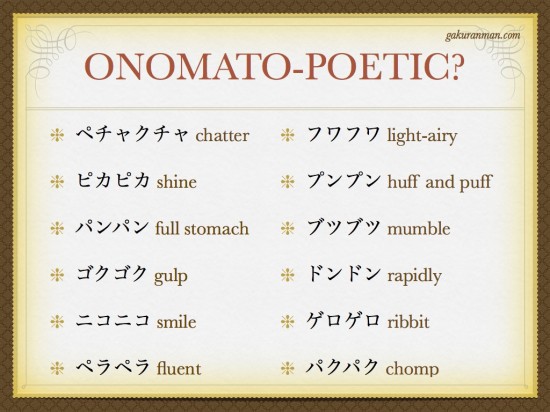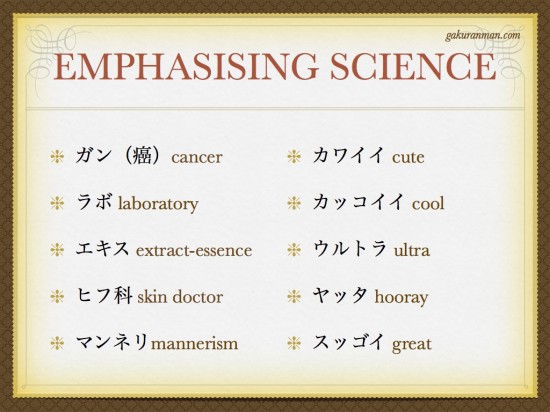Last time we looked at foreign expressions that make up a portion of Curious Katakana Words. Today we explore some useful onomatopoeic words you can use to really express yourself!
Firstly though, a quick note about the difference between onomatopoeic words and mimetic words.
Onomatopoeia, as we are taught in secondary school English classes, consists of words that sound like the thing they express. That is, they imitate the real sound of a subject or object. As you might guess, different languages have different ways of interpreting how something sounds. An example might be a frog’s croak. In English, ribbit-ribbit, but in Japanese, gero-gero.
Linguistic Mimesis (also known as Ideophones) is used to refer to words that evoke a very strong sensation of a particular thing. The biggest difference to onomatopoeia is that they do not actually have to resemble real sounds. Mimetic words can represent ideas, feelings or impressions of a sensory perception. For example, the shininess of golden objects might be expressed with bling-bling in English, or kira-kira in Japanese. No actual sound comes from gold, but hearing someone say ‘bling-bling’ evokes a strong sense of shininess. Cool, no?
See if you can identify which words are onomatopoeic and which are mimetic while you study :).
Onomatopoeia and Mimesis
ペチャクチャ
Chattering noise. Used especially to refer to people who are too talkative or noisy.
ピカピカ
Shiny, sparkly or reflective. I should imagine the Pokemon Pikachu got his name from this!
パンパン
A bloated full stomach. This evokes the image of something sticking out or bulging, ready to explode.
ゴクゴク
Gulp-gulp. Glug-glug. The noise of a liquid being drunk very hastily.
ニコニコ
Smiling or grinning. To be happy. If you write it like this: ニコッ you evoke the impression of a quick grin (the small Kana っ – called a 促音 in Japanese – is a glottal stop. You add a little pause before the next word. When it is used at the end of a word like this, imagine cutting off the end, making it shorter and snappier.
ペラペラ
Speaking in a fluent manner. Beginning learners will learn this phrase early as they are complimented on their Japanese skills.
フワフワ
Light or airy. It can also used to describe sickness when you feel faint or drunk, such as light-headedness. It really does ‘sound’ like a floaty cloud, no?
プンプン
Ever seen those cute Japanese girls that puff their cheeks out while frowning? Yup, that’s pun-pun. Harmless anger or irritation. Note that while it can be used in jest, it is also used seriously too.
ブツブツ
Mumble-mumble. The whispering, can’t-quite-hear sound of somebody speaking in a low voice. Also good for grumbling and being sulky.
ドンドン
Rapidly. This word imitates the feeling of advancing at a fast pace.
ゲロゲロ
Ribbit-ribbit. Gotta love frogs! Maybe croak-croak would work. No? Actually, gero in Japanese means ‘sick’ or ‘puke’ – the stuff you throw up. I always thought it a shame that a frog’s croak was the same word used to describe throwing up…
パクパク
Chomp-chomp. Munch-much. Any guesses where Pacman got his name? Yup, chomp-chomping his way through pellets.
Scientific/Technical Expressions
Next then, let’s take a look at some scientific and technical words – another thing Katakana is used for. There are of course many more, but being specialist and obscure, their use is limited. I kept the list trim.
ガン
Cancer. This can be written using Katakana, even though it has a kanji. Be careful not to confuse it with ガーン, which is a mimetic word evoking the feeling of shock or disappointment. The kind you might see in manga where the character is surrounded by vertical, black lines and has surprised expression.
ラボ
A laboratory. Again, another word to be careful not to confuse it with is ラブホ, which means ‘love hotel’!
エキス
The essense or extract of something. (Examples might be plant extracts used in moisturisers).
ヒフ科
A skin doctor / Department of Dermatology. The first two characters are sometimes written in katakana for simplicity. It literally means the ‘skin department’ (of a medical practice).
マンネリ
A mannerism. Not strictly scientific, but related to the arts world. It also means ‘to be stuck in a rut’, like when things are boring in a relationship.
Emphasis
To round up lesson 2 then, here are a few words used most often for expression. You’ll see them used over and over again on Japanese television game shows.
カワイイ
Cute. Elongate the final sound to add even more emphasis (and sound like a girl). カワイイ~~!Written in Kanji as 可愛い.
カッコイイ
Cool. The same nuance as the English word – something good, popular or attractive. Written in Kanji as 格好いい.
ウルトラ
Ultra. As used in the Japanese super hero’s name: Ultraman! ウルトラマン!
ヤッタ!
Hooray! Yes! I did it! Used to express happiness at the current situation, usually where something good has been achieved.
スッゴイ
Great! Several variations exist for this word. The common form is 凄い (すごい) just meaning ‘great’ or ‘amazing’ (in both a positive and negative sense). Extending the sounds and adding pauses gives the word extra punch. Like above: スッゴイ!or スゴイ~!Be careful of your pronunciation and attitude though, as they tend to mainly be used by girls!



Leave a Reply